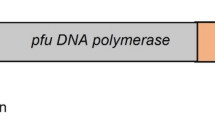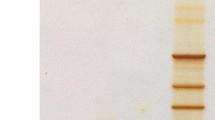Abstract
We tested the synthesis and in vitro activity of the poly(3-hydroxyalkanoate) (PHA) polymerase 1 from Pseudomonas putida GPo1 in both P. putida GPp104 and Escherichia coli JMU193. The polymerase encoding gene phaC1 was expressed using the inducible PalkB promoter. It was found that the production of polymerase could be modulated over a wide range of protein levels by varying inducer concentrations. The optimal inducer dicyclopropylketone concentrations for PHA production were at 0.03% (v/v) for P. putida and 0.005% (v/v) for E. coli. Under these concentrations the maximal polymerase level synthesized in the E. coli host (6% of total protein) was about three- to fourfold less than that in P. putida (20%), whereas the maximal level of PHA synthesized in the E. coli host (8% of total cell dry weight) was about fourfold less than that in P. putida (30%). In P. putida, the highest specific activity of polymerase was found in the mid-exponential growth phase with a maximum of 40 U/g polymerase, whereas in E. coli, the maximal specific polymerase activity was found in the early stationary growth phase (2 U/g polymerase). Our results suggest that optimal functioning of the PHA polymerase requires factors or a molecular environment that is available in P. putida but not in E. coli.




Similar content being viewed by others
References
Aldor AS, Keasling JD (2003) Process design for microbial plastic factories: metabolic engineering of polyhydroxyalkanoates. Curr Opin Biotechnol 14:475–483
de Roo G, Ren Q, Witholt B, Kessler B (2000) Development of an improved in vitro activity assay for medium chain length PHA polymerase based on coenzymeA release measurements. J Microbiol Methods 41:1–8
Diederich L, Roth A, Messer W (1994) A versatile plasmid vector system for the regulated expression of genes in Escherichia coli. BioTechniques 16:916–923
Ditta G, Stanfield S, Corbin D, Helinski DR (1980) Broad host range DNA cloning system for gram-negative bacteria: construction of a gene bank of Rhizobium meliloti. Proc Natl Acad Sci U S A 77:7347–7351
Durner RA (1998) Feast and Starvation: accumulation of bioplastic in Pseudomonas oleovorans. PhD thesis, Swiss Federal Institute of Technology Zürich, Zürich
Eggink G, Lageveen RG, Altenburg B, Witholt B (1987) Controlled and functional expression of the Pseudomonas oleovorans alkane utilizing system in Pseudomonas putida and Escherichia coli. J Biol Chem 262:17712–17718
Elvin CM, Thompson PR, Argall ME, Hendry P, Stamford NP, Lilley PE, and Dixon NE (1990) Modified bacteriophage lambda promoter vectors for overproduction of proteins in Escherichia coli. Gene 87:123--126
Fidler S, Dennis D (1992) Polyhydroxyalkanoate production in recombinant Escherichia coli. FEMS Microbiol Rev 103:231–236
Gerhardt H (1989) Peroxisomes and fatty acid degradation. Methods Enzymol 148:516–525
Gerngross TU, Martin DP (1995) Enzyme-catalyzed synthesis of poly[(R)-(−)-3-hydroxybutyrate]: formation of macroscopic granules in vitro. Proc Natl Acad Sci U S A 92:6279–6283
Gerngross TU, Reilly P, Stubbe J, Sinskey AJ, Peoples OP (1993) Immunocytochemical analysis of poly-beta-hydroxybutyrate (PHB) synthase in Alcaligenes eutrophus H16: localization of the synthase enzyme at the surface of the PHB granules. J Bacteriol 175:5289–5293
Gerngross TU, Snell KD, Peoples OP, Sinskey AJ, Csuhai E, Masamune S, Stubbe J (1994) Overexpression and purification of the soluble polyhydroxyalkanoate synthase from Alcaligenes eutrophus: evidence for a required posttranslational modification for catalytic activity. Biochemistry 33:9311–9320
Giza PE, Huang RC (1989) A self-inducing runaway-replication plasmid expression system utilizing the Rop protein. Gene 78:73–84
Han J, Qiu YZ, Liu DC, Chen GQ (2004) Engineered Aeromonas hydrophila for enhanced production of poly(3-hydroxybutyrate-co-3-hydroxyhexanoate) with alterable monomers composition. FEMS Microbiol Lett 239:195–201
Hockney RC (1994) Recent developments in heterologous protein production in Escherichia coli. Trends Biotechnol 12:456–463
Hoffmann I, Widstrom J, Zeppezauer M, Nyman PO (1987) Overproduction and large-scale preparation of deoxyuridine triphosphate nucleotidohydrolase from Escherichia coli. Eur J Biochem 164:45–51
Hrabak O (1992) Carbohydrates in industrial synthesis. In: Clarke MA (ed) Proceedings of the symposium of the division of carbohydrate chemistry of the American Chemical Society. Verlag Dr. Albert Bartens, Berlin, 18–26
Huijberts GNM, de Rijk TC, de Waard P, Eggink G (1995) 13C nuclear magnetic resonance studies of Pseudomonas putida fatty acid metabolic routes involved in poly(3-hydroxyalkanoate) synthesis. J Bacteriol 176:1661–1666
Huisman GW, de Leeuw O, Eggink G, Witholt B (1989) Synthesis of poly-hydroxyalkanoates is a common feature of fluorescent Pseudomonads. Appl Environ Microbiol 55:1949–1954
Huisman GW, Wonink E, Meima R, Kazemier B, Terpstra P, Witholt B (1991) Metabolism of poly(3-hydroxyalkanoates) (PHAs) by Pseudomonas oleovorans. J Biol Chem 266:2191–2198
Kraak MN, Kessler B, Witholt B (1997a) In vitro activities of granule-bound poly[(R)-3-hydroxyalkanoate] polymerase C1 of Pseudomonas oleovorans: development of an activity test for medium-chain-length-poly(3-hydroxyalkanoate) polymerases. Eur J Biochem 250:432–439
Kraak MN, Smits THM, Kessler B, Witholt B (1997b) Polymerase C1 levels and poly(R-3-hydroxyalkanoate) synthesis in wild-type and recombinant Pseudomonas strains. J Bacteriol 179:4985–4991
Laemmli UK (1970) Cleavage of structural proteins during the assembly of the head of bacteriophage T4. Nature 227:680–685
Lageveen RG, Huisman GW, Preusting H, Ketelaar P, Eggink G, Witholt B (1988) Formation of polyesters by Pseudomonas oleovorans: effect of substrates on formation and composition of poly-(R)-3-hydroxyalkanoates and poly-(R)-3-hydroxyalkenoates. Appl Environ Microbiol 54:2924–2932
Langenbach S, Rehm BHA, Steinbüchel A (1997) Functional expression of the PHA synthase gene phaC1 from Pseudomonas aeruginosa in Escherichia coli results in poly(3-hydroxyalkanoate) synthesis. FEMS Microbiol Lett 150:303–309
Madison LL, Huisman GW (1999) Metabolic engineering of poly(3-hydroxyalkanoates): from DNA to plastic. Microbiol Mol Biol Rev 63:21–53
Makrides SC (1996) Strategies for achieving high-level expression of genes in Escherichia coli. Microbiol Rev 60:512–538
Nieboer M (1996) Overproduction of a foreign membrane monooxygenase in E. coli: relation to membrane biogenesis. PhD thesis, University of Groningen, Groningen
Panke S (1999) Production of (S)-styrene oxide with recombinant bacteria. PhD thesis, Swiss Federal Institute of Technology Zürich, Zürich
Potter M, Madkour MH, Mayer F, Steinbuchel A (2002) Regulation of phasin expression and polyhydroxyalkanoate (PHA) granule formation in Ralstonia eutropha H16. Microbiol 148:2413–2426
Qi QS, Steinbüchel A, Rehm BHA (1998) Metabolic routing towards polyhydroxyalkanoic acid synthesis in recombinant Escherichia coli (fadR): inhibition of fatty acid beta-oxidation by acrylic acid. FEMS Microbiol Lett 167:89–94
Reddy CSK, Ghai R, Rashmi, Kalia VC (2003) Polyhydroxyalkanoates: an overview. Bioresour Technol 87:137–146
Rehm BHA (2003) Polyester synthases: natural catalysts for plastics. Biochem J 376:15–33
Ren Q, Sierro N, Witholt B, Kessler B (2000a) FabG, an NADPH-dependent 3-ketoacyl reductase of Pseudomonas aeruginosa, provides precursors for medium-chain-length poly-3-hydroxyalkanoate biosynthesis in Escherichia coli. J Bacteriol 182:2978–2981
Ren Q, Sierro N, Kellerhals M, Kessler B, Witholt B (2000b) Properties of engineered poly-3-hydroxyalkanoates (PHAs) produced in Escherichia coli recombinants. Appl Environ Microbiol 66:1311–1320
Ren Q, de Roo G, Kessler B, Witholt B (2000c) Recovery of active medium-chain-length poly-3-hydroxyalkanoates polymerase from inactive inclusion bodies using ion exchange resin. Biochem J 349:599–604
Ren Q, van Beilen JB, Sierro N, Zinn M, Kessler B, Witholt B (2005) Expression of PHA polymerase genes of Pseudomonas putida in Escherichia coli and its effect on PHA formation. Antonie van Leeuwenhoek 87:91–100
Rhie HG, Dennis D (1995) Role of fadR and atoC(Con) mutations in poly(3-hydroxybutyrate-co-3-hydroxyvalerate) synthesis in recombinant pha +Escherichia coli. Appl Environ Microbiol 61:2487–2492
Sambrook J, Fritsch EF, Maniatis T (1989) Molecular cloning: a laboratory manual. Cold Spring Harbor Laboratory, New York
Staijen IE, Hatzimanikatis V, Witholt B (1997) The AlkB monooxygenase of Pseudomonas oleovorans—synthesis, stability and level in recombinant Escherichia coli and the native host. Eur J Biochem 244:462–470
Steinbuchel A (2003) Production of rubber-like polymers by microorganisms. Curr Opin Microbiol 6:261–270
Steinbüchel A, Valentin HE (1995) Diversity of bacterial polyhydroxyalkanoic acids. FEMS Microbiol Lett 128:219–228
Sudesh K, Abe H, Doi Y (2000) Synthesis, structure and properties of polyhydroxyalkanoates: biological polyesters. Prog Polym Sci 25:1503–1555
Ueda H, Tabata Y (2003) Polyhydroxyalkanoate derivatives in current clinical applications and trials. Adv Drug Deliv Rev 55:501–518
Witholt B (1972) Method for isolating mutants overproducing nicotinamide adenine dinucleotide and its precursors. J Bacteriol 109:350–364
Acknowledgements
We thank Prof. D. Dennis for providing E. coli strain JMU193, Dr. M. Nieboer for providing plasmid pAlkVSVG1, Prof. S. Panke for providing plasmid pAlkSCm and Prof. H. Ploegh for providing monoclonal antibodies to the VSV G tag. We thank Dr. M. Passarge for preparing partially purified PhaC1.
Author information
Authors and Affiliations
Corresponding author
Rights and permissions
About this article
Cite this article
Ren, Q., de Roo, G., van Beilen, J.B. et al. Poly(3-hydroxyalkanoate) polymerase synthesis and in vitro activity in recombinant Escherichia coli and Pseudomonas putida . Appl Microbiol Biotechnol 69, 286–292 (2005). https://doi.org/10.1007/s00253-005-1995-1
Received:
Revised:
Accepted:
Published:
Issue Date:
DOI: https://doi.org/10.1007/s00253-005-1995-1




